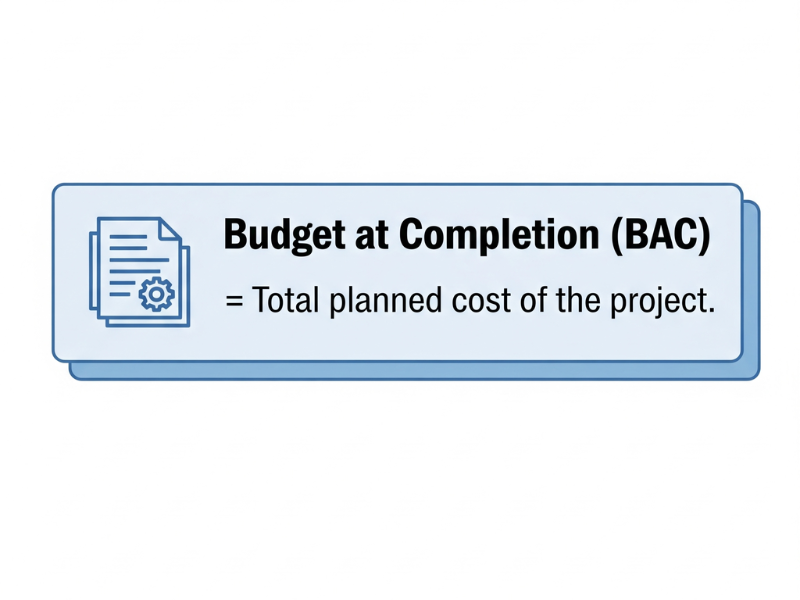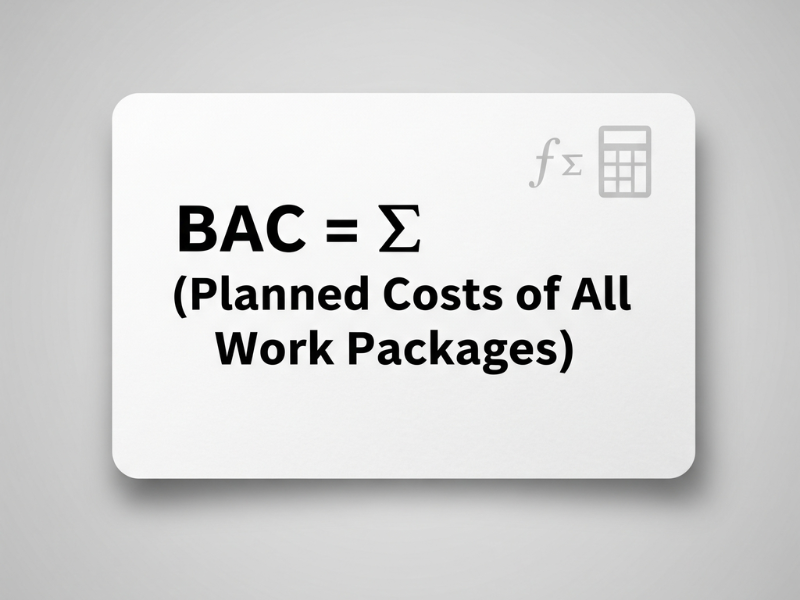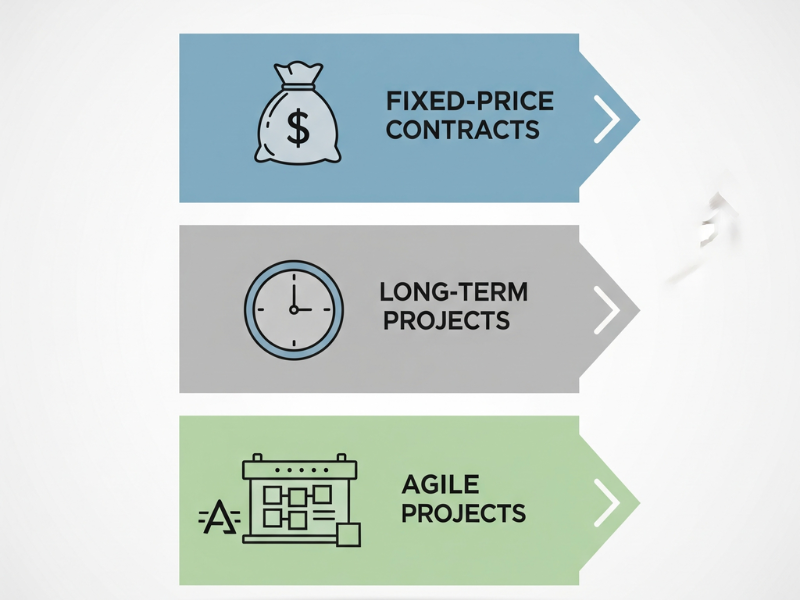Physical Address
304 North Cardinal St.
Dorchester Center, MA 02124
Physical Address
304 North Cardinal St.
Dorchester Center, MA 02124

Ever wonder why so many projects go over budget? According to the Project Management Institute, nearly 43% of projects exceed their planned costs. That’s where the Budget at Completion (BAC) comes in, it’s a simple but powerful calculation that tells you how much your project is expected to cost once it’s finished.
In this guide, I’ll walk you through exactly how to calculate Budget at Completion, what it means in real-world project management, and how you can use it to keep your projects under control. Whether you’re new to earned value management or just need a refresher, you’ll leave with a clear understanding of BAC and how to apply it in 2025.

Budget at Completion, or BAC, is the total budgeted cost for a project as agreed in the baseline.Think of it as the price tag on the project when everything is planned and signed off.It shows the money you expect to spend from start to finish, based on the approved scope, schedule, and cost baseline.
BAC is not about what you’ve spent so far.It is the total planned budget for the whole job, at completion.If the scope changes, the BAC should be reviewed, because that original number was based on the original assumptions.
These three terms often get mixed up.They are related, but each answers a different question about project finances.
Planned Value is how much of the BAC you planned to have “earned” by a certain date.It is the budgeted cost of the work scheduled.PV tells you what you planned to do, cost-wise, by now.
Earned Value is the budgeted value of the work you actually completed by a date.EV tells you the portion of the BAC you have earned based on progress, not cash spent.It measures real progress against the plan.
PV and EV are both slices of the BAC.PV is the planned slice, EV is the real slice you actually earned.BAC is the whole pie; PV and EV are the slices you compare to see whether the project is on track.
BAC anchors the entire earned value system.Without a reliable BAC you cannot calculate key metrics like variance or forecasted totals.It is the foundation for measuring performance, forecasting, and communicating financial status to stakeholders.
A correct BAC lets you spot overruns early, not after the project is finished.When EV is lagging behind PV, or AC is higher than EV, the BAC helps you see the gap.That gap is what triggers corrective action, budget reallocation, or scope review.
Stakeholders use BAC to gauge whether the project will finish within budget.Project managers use it to justify changes or request contingencies.It creates accountability because it ties performance metrics back to a single, agreed number.
Imagine a software project with a BAC of $100,000.By month six the team has delivered work valued at $40,000 and has spent $45,000 in actual costs.That means the project is 40 percent complete by earned value and is spending more than the value produced.
Earned Value over BAC equals percent complete, so 40,000 divided by 100,000 equals 0.4, or 40 percent complete.Cost Performance Index is EV divided by AC, which is 40,000 divided by 45,000 giving about 0.889, meaning roughly 88.9 percent efficiency.Those numbers tell you: heads up, you are behind in value versus cost and need to investigate why actual cost is outpacing earned value.
If your CPI is below 1, you are spending more than the value you are earning. You can use BAC to forecast whether you will need more funds, or whether scope or productivity must be changed. Update your stakeholders early and be transparent about assumptions, it saves you from the bigger surprise later.
I once treated BAC like a paperwork item and forgot to update it after a midproject scope tweak.We ended up scrambling for contingencies later, and that stress could have been avoided with one small review meeting. So here’s the tip: review BAC at every major scope change and keep the baseline documented.

The formula for Budget at Completion (BAC) looks almost too simple:
BAC = Σ (Budgeted Cost of All Work Packages)
In plain English, that means you just add up all the planned costs for every task, milestone, or deliverable in the project. The sum of those planned costs is your BAC. Nothing fancy, just the total amount you expect to spend to get everything done.
I like to think of it like planning a wedding. You budget for the venue, catering, flowers, music, and little extras. Add all those line items together and boom, that’s your total wedding budget. That’s exactly how BAC works in project management.
Let’s say you’re managing a small marketing project:
Now add those up:
4,000 + 6,500 + 2,500 + 1,000 + 3,000 = $17,000 BAC
That $17,000 is your Budget at Completion. It’s the number you’ll constantly compare against Earned Value (EV), Planned Value (PV), and Actual Costs (AC) as the project moves along.
I once underestimated a project’s BAC because I didn’t include software licensing fees that were “already covered” by another department. Turns out, they weren’t. Midway through the project, we had to scramble to find $2,000 more. Ever since, I double-check every indirect cost, even if it feels minor, because those “small” items add up fast.
BAC isn’t just a number sitting in a spreadsheet, it’s your compass for where the project’s finances are heading. By comparing BAC with actual costs (AC) and earned value (EV), you can forecast whether the project will finish within the approved budget. Without BAC, forecasting feels like driving without a fuel gauge, you’ll only know you’re out of gas when the car stops.
BAC allows you to answer the big question stakeholders always ask: “How much will this project actually cost us in the end?” Having a reliable forecast builds trust and helps you make proactive adjustments.
Projects rarely fail overnight. Cost overruns creep in slowly, and if you’re not watching, they blindside you. That’s where BAC comes in. By comparing what’s been spent and earned so far against BAC, you can see red flags early.
For example, if by mid-project you’ve already spent 70% of the BAC but only completed 40% of the work, you know trouble is brewing. That early signal gives you time to act, maybe renegotiate vendor contracts, cut scope, or reassign resources, before the budget spirals out of control.
BAC also links directly to other project health indicators. The Cost Performance Index (CPI) is calculated using Earned Value (EV) and Actual Cost (AC), but it ties back to BAC when you forecast the Estimate at Completion (EAC).
The formula EAC = BAC / CPI is one of the most common ways to predict final project cost. If your CPI is less than 1, EAC will be higher than BAC, signaling an overrun. If CPI is greater than 1, you’re actually spending less than planned—something clients love to hear.
In short, BAC isn’t isolated, it’s the foundation for understanding project performance as a whole.
Stakeholders aren’t usually interested in formulas or earned value jargon, they just want to know if the project will finish on budget. BAC gives them a clear, agreed-upon number they can anchor to.
Clients care because BAC represents their financial commitment. Executives care because it ties into profitability and resource allocation. And project managers? Well, we care because BAC is how we prove we can deliver on promises.
I once had a client who was nervous because they’d been burned before by a project that went 50% over budget. When I presented a BAC-backed forecast early in the project and updated it monthly, their confidence skyrocketed. We ended up delivering slightly under budget, and that client became one of my best repeat customers.
The bottom line: BAC isn’t just math, it’s trust, credibility, and control wrapped into a single number.

In fixed-price contracts, BAC is straightforward, the agreed contract amount is the BAC. It doesn’t matter how many hours your team works or if material costs shift; the budget is fixed, and your job is to manage within it. The danger here is underestimating hidden costs, which eats into margins.
With variable budgets, BAC can flex depending on scope, resource use, or client approvals. In these cases, your BAC may shift over time, so tracking baseline changes is essential. I once worked on a variable-budget project where the client kept requesting “just small changes.” Those tiny changes snowballed into a 20% budget increase because we didn’t formally update BAC at each stage. Lesson learned, lock changes in writing and recalculate BAC.
In long-term projects, BAC is more vulnerable to external factors like inflation, labor rate changes, or market shifts. A project that spans multiple years needs regular BAC reviews; otherwise, you might find yourself wildly off by the halfway mark. Short-term projects, on the other hand, usually have more stable BACs because the timeline is too short for big financial shifts to creep in.
Still, even for small projects, scope creep can wreck the BAC if you’re not careful. I once underestimated a 3-month project simply because I assumed costs wouldn’t fluctuate. By the end, contractor overtime drove us 15% over the original BAC. Short doesn’t mean safe, review your numbers regularly.
People often think BAC doesn’t apply to agile projects because budgets feel more flexible. But even in agile, you need an overall financial ceiling. BAC in agile typically looks like the total budget for all planned sprints. Each sprint then consumes a portion of that BAC.
In hybrid settings, where you mix agile sprints with waterfall planning, BAC is critical. You’ll have high-level budget commitments (like in waterfall) while still adjusting sprint by sprint (like in agile). Keeping BAC updated ensures the agile side doesn’t balloon costs without the waterfall side noticing.
These days, you don’t need to calculate BAC manually unless you want to. Tools like Microsoft Project, Primavera P6, and even Trello integrations can automate the math once you enter planned values.
More advanced software like Monday.com or Smartsheet now integrate earned value management features, letting you see BAC alongside PV, EV, and AC in real time. Even Excel templates can work for smaller projects, as long as you’re disciplined about updating inputs.
Personally, I prefer a combination: Excel for initial BAC calculation (because I like seeing the formulas) and project management software for ongoing tracking. That way, I get the best of both worlds, clarity and automation.
And here’s the truth: in 2025, with AI-driven forecasting in tools like ClickUp and Wrike, BAC tracking is easier than ever. But no tool replaces discipline, you still have to feed it accurate, up-to-date data.
One of the biggest mistakes I made early in project management was updating costs “when I had time.” Spoiler: I never had time, and my BAC comparisons were always outdated. Tracking actual costs consistently, weekly or even daily, makes your BAC meaningful. Without current data, BAC is just a number on paper.
It’s not about being a control freak; it’s about giving yourself reliable info to spot overruns. A simple routine, like setting aside 30 minutes every Friday to log costs, can save you from major surprises later.
Projects rarely stay exactly as planned. A client might add features, suppliers may delay shipments, or risks become realities. Every change in scope should trigger a BAC review. If you don’t, your baseline will be a fantasy while your actual spending tells a harsher story.
I learned this the hard way on a construction project where a minor design change doubled material costs. We didn’t update BAC right away, and stakeholders thought we were “on budget.” When the truth surfaced, trust took a hit. Now, I always tie BAC updates to scope change approvals.
Manual calculations work, but software reduces human error and saves time. Most modern project management tools allow you to input planned values and actuals, then automatically recalculate BAC-related metrics.
Tools like MS Project, Primavera, or even affordable options like Smartsheet make it easy to visualize BAC against PV, EV, and AC. For smaller teams, Excel with macros can also get the job done. The key is consistency, automated or not, you must feed the system with accurate inputs.
I once shadowed a project where BAC was calculated at the start and then forgotten. By the halfway mark, actual costs were already 80% of BAC while only 50% of work was complete. Nobody realized until it was too late. That project finished 30% over budget, and the team spent months doing damage control with the client.
The lesson? BAC isn’t “set it and forget it.” It’s a living number. Ignoring it is like ignoring your bank balance while shopping, you’ll only notice the overdraft fee later.
If there’s one habit worth building, it’s making BAC reviews a regular checkpoint in your project cycle. Not flashy, but it’s the difference between steering a project with headlights on versus in the dark.
To really understand how Budget at Completion (BAC) works, let’s walk through a practical example. This will show you not only the math but also how the numbers help guide better project decisions.

Imagine you’re managing a website redesign project for a client. The scope includes design, development, content migration, and testing. You’ve planned the following costs:
Total estimated cost = $100,000
This total estimated cost is your Budget at Completion (BAC) — the full amount you expect the project to cost when it’s finished.
The standard BAC formula is:
BAC = Σ (Planned Cost of Work for Each Task)
Step 1: List each task and its planned cost.
Step 2: Add them up.$20,000 + $50,000 + $15,000 + $10,000 + $5,000 = $100,000
Step 3: Confirm this is your Budget at Completion (BAC).So, BAC = $100,000.
In Earned Value Management (EVM), BAC is one of the anchor numbers used to measure performance. Once the project is underway, you’ll compare:
By comparing these with your BAC ($100,000), you can forecast:
In our example, the BAC of $100,000 becomes the baseline for all cost tracking. If halfway through the project you’ve spent $60,000 but only completed 40% of the work, that’s a warning sign. The BAC shows you should have only spent about $40,000 by this stage, meaning costs are running high.
This visibility allows project managers and stakeholders to:
In short, BAC is more than just a number, it’s the lens that reveals whether a project is financially healthy and on track for success.
Many project managers only count direct costs like materials and labor, but forget about overhead, admin support, or software subscriptions tied to the project. Leaving these out gives you a BAC that looks healthier than reality.
BAC (Budget at Completion) is the original budget baseline. EAC (Estimate at Completion) is the updated forecast based on actual performance. Confusing the two can lead to misleading reports. Always clarify which one you’re presenting to stakeholders.
If the scope changes and BAC isn’t updated, your budget tracking becomes irrelevant. A “perfect” BAC that ignores change orders is basically fiction.
Software can automate BAC calculations, but it’s only as good as the numbers you feed it. Garbage in, garbage out. Always verify inputs before relying on automated reports.
You might have the math right, but if stakeholders don’t understand how BAC is calculated or updated, you risk losing their trust. Numbers don’t speak for themselves, you do.
Understanding how to calculate Budget at Completion (BAC) isn’t just about running formulas. It’s about giving your project a financial compass. With BAC, you can see whether your resources match your ambitions, whether your costs are drifting off course, and how prepared you are to respond before overruns spiral out of control.
The most effective project managers use BAC not as a one-time calculation, but as a living checkpoint throughout the project’s lifecycle. When combined with earned value analysis, cost performance indexes, and modern project management tools, BAC transforms from a simple number into a clear story of project health.
As you move forward, think of BAC as your early warning system and your guide for smarter decisions. Projects succeed not by luck, but by visibility and control, and BAC is one of the sharpest tools to keep both firmly in your hands.
Want to dive deeper into financial topics? Check out our other guides: